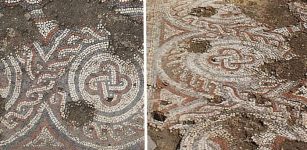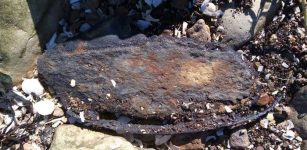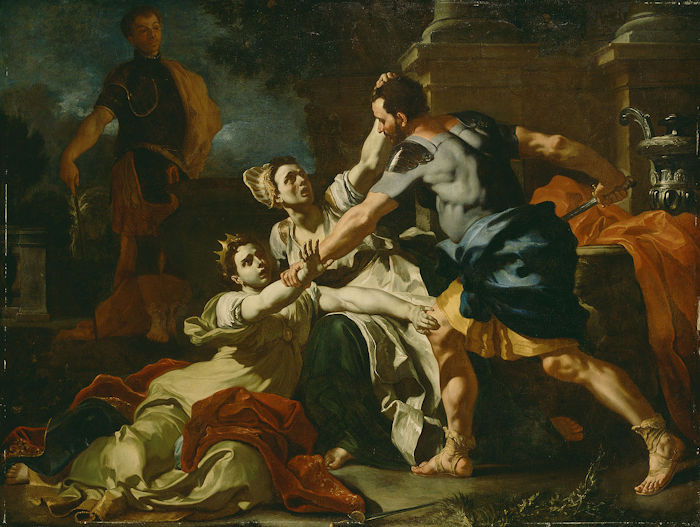Ancient Roman Laws Give Us A Window Into A World Of Abuse
AncientPages.com - Domestic violence was endemic in the Roman world.
Rome was a slave-owning, patriarchal, militarized culture in which violence (potential and actual) signaled power and control.
Tragically, but predictably, the names of most of the victims of domestic violence do not show up in the historical record. And yet the identities of a handful of victims survive.
Death of Messalina by Francesco Solimena (1657–1747). Credit: Public Domain
Nero's second wife Poppaea Sabina was kicked to death while pregnant. His first wife Octavia and his mother Agrippina were murdered on his orders.
According to her epitaph, Julia Maiana was killed after 28 years of marriage. Appia Annia Regilla, an aristocratic woman and wife of the Greek author Herodes Atticus, was murdered while pregnant. Prima Florentia was drowned. Apronia was thrown from a window.
The love poets Ovid and Propertius depicted relationships with "Corinna" and "Cynthia" involving physical abuse.
John Chrysostom, a church father, described the nightly shrieks of women echoing through the streets of Antioch.
The Roman household
Relationships between members of the Roman household (both free and enslaved) were characterized by significant power imbalances—a scenario ripe in possibilities for physical, sexual and psychological abuse and coercive control.
The head of the Roman household, the pater familias, was famously powerful. His power included the so-called "power of life and death" and ownership of the property of even adult children within his control.
His wife might exercise violence and coercion (for instance against slaves, lovers, or children) and be its victim.
With a society-wide belief in correctional education, children were often victims of violence. There is also scattered evidence for elder abuse and the routine sexual and physical abuse of slaves.
Legal responses to domestic violence
The autonomy and authority of the pater familias, the comparative ease with which a Roman marriage could be dissolved and endemic inequality have been viewed as reasons why Rome did not develop specific domestic violence legislation.
But a patchwork of Roman laws (including Rome's complex murder laws) sought to address coercive and violent behavior.
The first Roman emperor, Augustus (27 BCE until 14 CE), brought in anti-adultery legislation, criminalizing extra-marital sexual activity. This legislation was a deliberate and unprecedented intrusion into the realm of the family, including limits on circumstances under which a father could kill his daughter.
Guillaume-Guillon Lethière, The Death of Virginia (circa 1800) Los Angeles County Museum of Art
Stalking and sexual harassment were illegal—although the law focused on preserving a woman's chastity, not on the perpetrator's desire to control or terrify his victim.
The emperors Theodosius (379 to 395) and Valentinian (364 to 375) accepted physical abuse as a just cause for divorce—but this appears to have been revoked under the emperor Justinian (542).
The emperor himself was known on occasions to have taken an interest in specific domestic murder cases, but his intervention probably depended on the status and connections of the complainants.
Laws which incidentally addressed abuse and coercive control were much more common. Roman laws offered extensive and detailed legal provision for dowries, wills and inheritance. Laws provided recourse for a child wrongfully disinherited and worked against a pater familias who intentionally cheated a wife out of her dowry.
The need for these laws opens a window on a world of abuse.
'Good fatherhood'
If the law rarely directly addressed domestic violence, a public rhetoric of "good fatherhood" did seek to speak to family duties and relationships.
Exemplary fathers exercised self-control and restrained their anger. They showed severity and pietas (familial duty) rather than cruelty.
Angelo Visconti, The Massacre of the Innocents (1860 - 1861) Asciano, Cassioli Museum
This rhetoric was made use of by the emperor Hadrian (117 to 138) who exiled a father who had killed his son.
The emperor Trajan (98 to 117) also ordered a father who was maltreating his son to set him free since he viewed the treatment as a breach of pietas.
Of course, not all acts of violence were punished. When Egnatius Mecenius beat his wife to death with a club for being drunk (a story dating back to the legendary days of Romulus), he was commemorated for his exemplary severitas (acceptable strictness).
The voices of women
Roman matrons could be respected and influential figures within both household and state.
The ancient Roman historian Livy gave an account of the public murder of Verginia by her father, who killed her in order to protect her chastity from an abuser.
Nero and Agrippina, painted by Antonio Rizzi (1869-1940). Credit: Public Domain
In his telling of the story, Livy examines the public presence of women during the incident. He depicts a crowd of respectable matrons standing with Verginia throughout her ordeal, jostling her accuser.
Their weeping moved the crowd of onlookers more than her father's complaints.
After her murder, Livy reports the women lamented loudly and publicly: the actions of the male protagonists are highlighted through the protesting voices of the matrons.
The presence of domestic violence in ancient Rome may not be surprising. But of interest is how Romans formulated limited legal and non-legal challenges to cultures of violence and how we can continue to interrogate such responses today.
This article is republished from The Conversation under a Creative Commons license. Read the original article.![]()
More From Ancient Pages
-
 On This Day In History: Maltese Rebellion Took Place – On Sep 8, 1775
News | Sep 8, 2016
On This Day In History: Maltese Rebellion Took Place – On Sep 8, 1775
News | Sep 8, 2016 -
 Ancient City Of Laodicea With One Of ‘Seven Churches Of Asia’ Founded By The King Antiochus II
Featured Stories | Jul 26, 2021
Ancient City Of Laodicea With One Of ‘Seven Churches Of Asia’ Founded By The King Antiochus II
Featured Stories | Jul 26, 2021 -
 Ancient Knowledge About The Cycle Of Renewal And The Next Human Phase – Gods And Guardians Of The Earth
Ancient Mysteries | Feb 16, 2020
Ancient Knowledge About The Cycle Of Renewal And The Next Human Phase – Gods And Guardians Of The Earth
Ancient Mysteries | Feb 16, 2020 -
 First 5th Century Mosaic Found Near Cirencester Once The Second-Largest Roman-British Town In England
Archaeology | Dec 16, 2020
First 5th Century Mosaic Found Near Cirencester Once The Second-Largest Roman-British Town In England
Archaeology | Dec 16, 2020 -
 Europe’s Earliest Culture Of Aurignacian People Made Amazing Images With Dots
Archaeology | Mar 5, 2017
Europe’s Earliest Culture Of Aurignacian People Made Amazing Images With Dots
Archaeology | Mar 5, 2017 -
 Strange Community Rules Of Essenes Preserved In The Dead Sea Scrolls
Ancient History Facts | Jun 9, 2020
Strange Community Rules Of Essenes Preserved In The Dead Sea Scrolls
Ancient History Facts | Jun 9, 2020 -
 Deadly Ancient Secrets Of Queen Hatshepsut’s Flacon
Artifacts | Mar 18, 2017
Deadly Ancient Secrets Of Queen Hatshepsut’s Flacon
Artifacts | Mar 18, 2017 -
 Ancient Egypt Life and Death in the Valley of the Kings Death
Civilizations | Sep 2, 2015
Ancient Egypt Life and Death in the Valley of the Kings Death
Civilizations | Sep 2, 2015 -
 Our Ancestors Collected Shells 100,000 Years Ago To Create Personal Identity
Archaeology | Oct 6, 2023
Our Ancestors Collected Shells 100,000 Years Ago To Create Personal Identity
Archaeology | Oct 6, 2023 -
 America’s Oldest City Caral Illegally Invaded And Archaeologist Threatened With Death
Archaeology | Jan 21, 2021
America’s Oldest City Caral Illegally Invaded And Archaeologist Threatened With Death
Archaeology | Jan 21, 2021 -
 Ice Age Engraved Stones, Tools Unearthed At Jersey Hunter-Gatherer Site Dated To Magdalenian Culture
Archaeology | Nov 3, 2015
Ice Age Engraved Stones, Tools Unearthed At Jersey Hunter-Gatherer Site Dated To Magdalenian Culture
Archaeology | Nov 3, 2015 -
 Magnificent ‘Sword Pyramid’ Lost By A Sutton Hoo-Era Lord Discovered In Norfolk
Archaeology | Aug 21, 2021
Magnificent ‘Sword Pyramid’ Lost By A Sutton Hoo-Era Lord Discovered In Norfolk
Archaeology | Aug 21, 2021 -
 Land of Israel: A 5,000-Year-Old Settlement And A Pottery Kiln Unearthed Near Beit Shemesh At The Site Of Hurvat Husham
Archaeology | Oct 30, 2024
Land of Israel: A 5,000-Year-Old Settlement And A Pottery Kiln Unearthed Near Beit Shemesh At The Site Of Hurvat Husham
Archaeology | Oct 30, 2024 -
 Mystery Of The Lost Arctic Civilization- Two Ancient Mummies Found At The Zeleny Yar Necropolis
Archaeology | Jul 20, 2017
Mystery Of The Lost Arctic Civilization- Two Ancient Mummies Found At The Zeleny Yar Necropolis
Archaeology | Jul 20, 2017 -
 30 Ancient Skeletons May Finally Unravel The Secrets Of The Dead Sea Scrolls
Archaeology | Nov 23, 2017
30 Ancient Skeletons May Finally Unravel The Secrets Of The Dead Sea Scrolls
Archaeology | Nov 23, 2017 -
 Pharaoh Ahmose I Expelled The Hyksos Invaders And Changed History Of Ancient Egypt
Featured Stories | Mar 16, 2021
Pharaoh Ahmose I Expelled The Hyksos Invaders And Changed History Of Ancient Egypt
Featured Stories | Mar 16, 2021 -
 Amazing Margate Shell Grotto – Kent’s Greatest Mystery
Featured Stories | Jun 10, 2014
Amazing Margate Shell Grotto – Kent’s Greatest Mystery
Featured Stories | Jun 10, 2014 -
 What Did A Day In Pharaoh’ s Life Look Like?
Ancient History Facts | Dec 9, 2019
What Did A Day In Pharaoh’ s Life Look Like?
Ancient History Facts | Dec 9, 2019 -
 Why Is Caganer, The Pooping Man Part Of The Catalonian Christmas Tradition And Nativity Scene?
Christmas Traditions | Dec 18, 2024
Why Is Caganer, The Pooping Man Part Of The Catalonian Christmas Tradition And Nativity Scene?
Christmas Traditions | Dec 18, 2024 -
 3,000-Year-Old Shoe Found On A Beach In Kent, UK
Archaeology | Feb 24, 2023
3,000-Year-Old Shoe Found On A Beach In Kent, UK
Archaeology | Feb 24, 2023




